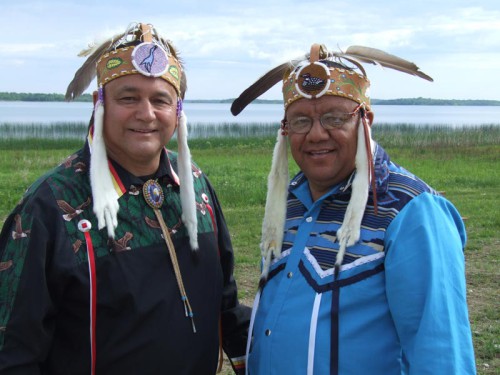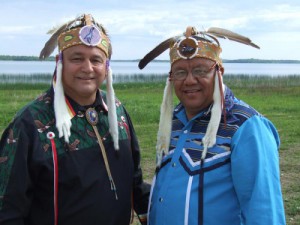The Recorder
SHEGUIANDAH—The grand council of the Union of Ontario Indians (Anishinabek Nation) made history during the June 5 to 6 gathering at Sheguiandah First Nation.
Beneath coloured banners bearing clan symbols, the leaders of the communities comprising the Anishinabek Nation began the process of adopting one of the most important symbols in re-establishing sovereignty over their own internal destinies—the adoption of a constitution.
“The symbolism is very significant,” said Grand Council Chief Patrick Madahbee, who was acclaimed to his post along with Deputy Grand Chief Glen Hare during nominations on Tuesday. “It sends the message that we have never given up our sovereignty.”
Chief Madahbee channeled the words of the late Canadian Prime Minister Pierre Elliott Trudeau, fully conscious of the irony contained within the citation, speaking of Canada being “ready to break the shackles of colonialism” during the repatriation of the constitution of Canada. “How ironic,” said Chief Madahbee. “Trudeau spoke of Canada being on the path to nation building and the strength of the collective will a people.”
“Nations make treaties,” said the Grand Chief, “but treaties do not make nations.” He went on to predict that the Anishinabek Nation constitution will be “a powerful force for change” in its own right.
The new constitution for the Anishinabek Nation has been in the works for some time, and a previous version failed to be proclaimed at the last UOI grand council after opposition from some community leaders who felt there had not been enough consultation and debate.
Chief Madahbee suggested that delay will be proven by history to have been a good thing. He noted that there was still some opposition from a small number of communities to the present. “This is the beginning of a journey—a first step down the path,” he said. “Governments try to shove things down peoples throats. We respect communities wanting to take their time.”
“The strength lies not in the words, but in the strength of our people,” he said.
Chief Madahbee credited his, and his deputy’s acclamations, to one key element. “I think it shows that we have been listening to the people,” he said. “Both myself and the Deputy Chief have been to every community in our territory. We have been working very hard. I think the chiefs are acknowledging the hard work we have done.”
“On this day it is a recognition that our citizens have had a voice,” agreed Deputy Chief Hare. “It is their voice, their word, I know that they are proud.”
Both leaders stressed that they work well as a team and credit each other with playing a significant role in the success they have achieved for their communities.
Although the self-described dynamic duo were acclaimed, the ceremony of induction into their roles suffered no lack of symbolism, pomp or circumstance.
Elder Gordon Waindubence and his young assistants prepared the blankets, pipe and bonnets, anointing them with water and the smoke of sacred medicines. The two leaders were taken through the ceremonial induction one at a time.
First it was Deputy Chief Hare who was led to the centre of a blanket bearing the emblem of the Thunderbird and sat crosslegged. Four women then carried the bonnet bearing the relevant clan symbol and placed it on his head. The women then assisted the candidate to stand and wrapped him in the blanket. Each woman in turn admonished the leader to follow a righteous path during his tenure.
Following the ceremony, the chief and his deputy gave impassioned speeches before they grasped eagle staffs and the assembled chiefs lined up behind them for a procession around the lodge, the sound of the drum and singers ringing out to proclaim the renewed leadership.





